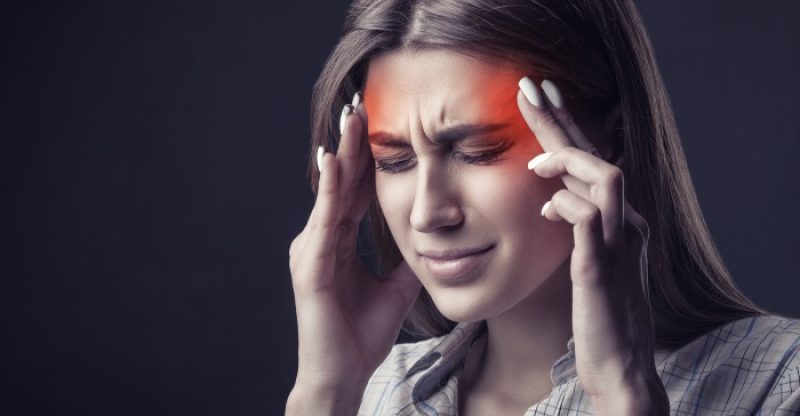16 Science-Backed Home Remedies for Headaches
When we have symptoms, such as a headache, our body is usually trying to tell us we are missing something essential.
While headaches are common, especially as life gets busy and we become stressed, overlooking signals from our body and masking them with pain relievers is not a good idea.
Learn more about what a headache could be saying about your body, as well as natural ways to treat a headache that will not give you side effects when you read our guide to home remedies for headaches.
The pain of a headache could be telling you that you are missing out on some essentials for healthy living.
It could be water, a break from stress, key nutrients, or many other factors.
And knowing what is causing your headache is helpful when deciding how to treat it.
Below, we give you all the information you need to treat your headache at home using natural ingredients and lifestyle changes.
The first step is listening to your body’s warnings, which come in the form of headaches, that something is missing or wrong, then working to correct the imbalance that is causing you pain.
First, we examine the primary causes for most headaches, which can provide direction for how to treat them.
Types of Headaches
A headache is a prevalent symptom of all kinds of disorders and ailments.
Nearly half of all people on the planet will get a headache this year, and while some are more serious, most are easily treatable (1).
Understanding what causes headaches can help you select the best possible treatment.
While there are over 150 types of headaches, when you examine all cases, there are four common ones that account for the vast majority thereof.
These are tension headaches, sinus headaches, migraine headaches, and cluster headaches.
Tension Headaches
Tension headaches are the most common type of this complaint.
Tension headaches are common among adults and teens, and these are sometimes referred to as stress headaches, chronic non-progressive headaches, or chronic daily headaches.
Nearly 90% of all headaches are tension-type headaches, and they affect over a billion and a half people annually (2).
Women are more likely than men to suffer from tension headaches.
Tension headaches cause mild to moderate pain, which can come and go or may be chronic in nature.
The pain of tension headaches generally radiates from the lower part of the back of the head, the eyes, or the neck.
Pain is typically on both sides of the head with this type of a headache.
Sinus Headaches
When your sinuses become inflamed, this can create pressure and cause pain on the bridge of your nose, across your forehead, and behind your cheeks.
Sinus headaches are usually accompanied by other sinus-related symptoms, such as a running nose, pressure in your ears, fever, or congestion.
Sinus headaches are common for those who suffer from seasonal allergies.
Migraine Headaches
Migraine headaches are different than other types of headaches in many ways.
While most headaches resolve quickly, migraines can last anywhere from a few hours to several days.
Most people who get migraine headaches get at least once a month, with many experiencing multiple.
The pain from migraines is usually limited to one-half of the head and is generally pulsating in nature (3).
Other symptoms associated with migraine headaches include sensitivity to smell, sound, or light, nausea, and vomiting.
While we do not fully understand the cause or causes of migraines at this time, they are believed to be primarily due to genetic factors combined with environmental influences, as two out of three people who get migraines have a family history of this headache disorder (4).
Cluster Headaches
Cluster headaches represent the most severe type of headache disorder, but they are also the rarest.
Cluster headaches are recurrent, severe headaches known for their intense, piercing pain, often focused behind one eye.
Symptoms of cluster headaches can last anywhere from a few minutes to several hours.
The disorder gets its name because headaches occur in clusters, with some lasting a few weeks or months, but clusters can last more than a year.
Clusters can also go into remission for extended periods, then reappear suddenly.
The cause of cluster headaches is not known, but it is tied to genetic factors.
Exposure to tobacco smoke seems to play a role, as well (5).
Causes and Risk Factors for Headaches
Different headaches have different causes, but in general, headaches happen when the muscles and blood vessels in your head send signals to nerve endings.
Headache triggers vary, but it is not always known what causes these signals to fire and cause pain.
The most common headache triggers include:
- Stress;
- Ailments like colds, fever, and throat or sinus infections;
- Environmental influences, like strong smells or tobacco smoke;
- Eyestrain;
- Back or neck pain;
- A family history of headaches, particularly migraine headaches;
- Hormonal imbalances;
- Allergies to foods or medications;
- Deficiency of certain minerals or vitamins;
- Sensitivity to food additives, like aspartame (6).
Understanding these causes and the nature of the various types of headaches can help you select the best treatment for your particular headache pain.
Below are our favorite natural, at-home remedies for treating headache pain.
Natural Headache Treatments
Magnesium
Many who experience migraine headaches find relief by taking magnesium supplements.
Magnesium is a mineral our bodies need for many important functions, and those with migraines are often deficient in this essential nutrient.
If you have low-level migraines, taking a regular magnesium supplement could decrease the frequency of your headaches.
Others who are more likely to have low levels of magnesium are those with heart disease, diabetes, alcoholism, and those who take diuretics to control their blood pressure.
While it is not completely clear how magnesium supplementation helps a migraine, it is suggested that magnesium may block certain brain signaling related to sensory and visual changes that are often responsible for headaches, especially migraines.
Magnesium also blocks pain transmission in your brain, which can prevent attacks or make them less severe (7).
Foods rich in magnesium also include those high in fiber.
Vegetables, especially leafy greens, broccoli, and squash, as well as beans, whole grains, and nuts are rich in this essential mineral.
If you are not getting enough magnesium from your diet, take up to 600 milligrams per day to control your headaches.
Because many people are deficient in this nutrient and do not even know it, taking magnesium is likely to have no adverse effects.
If you notice any changes in your bowels, especially diarrhea, reduce your dosage or take it less frequently, and this side effect should go away.
Use a Compress
Depending on the type of a headache you have, either a hot or a cold compress can often be very effective at reducing your pain and making you feel better.
It can sometimes be difficult to determine which temperature will be effective for you, so you may have to use some trial and error at first.
Some headaches are the result of expanded blood vessels.
These press on nerves, which cause pain.
If this is the case for your headache, a cold compress can reduce pressure and alleviate pain.
This is especially helpful with sinus headaches.
Tension or other types of headaches brought on by anxiety and other factors can be helped with the heat.
Cold can actually cause muscles to tense further, pinching nerves and enlarging blood vessels.
In this case, a warm compress can relax and loosen tight muscles that are causing your headache.
Experimenting with various temperatures may be beneficial for finding an easy and simple remedy for your headache.
Often, alternating between temperatures works best, so find what works for you.
You can use an ice pack, cold pack, or bag of frozen vegetables for a cold compress, and a washcloth soaked in warm water for a warm compress.
Lie down with the lights off, then experiment with placing the compress on different locations.
Common areas that offer relief include the top of the head, the back of the head, the neck, the shoulders, and the sinus area.
It all depends on your headache and your body’s response to the compress.
See a Chiropractor
Chiropractic care is a safe, drug-free way to get relief if you experience frequent headaches.
A chiropractor skilled in spinal manipulation can help treat your headaches over time.
Some who receive chiropractic care see as much as a 90 percent reduction in headaches.
Nearly half of everyone who visits a chiropractor regularly sees a significant decrease in headache pain (8).
Chiropractic care helps reduce tension, ease stress, and can treat the source of headache pain.
Herbal Treatments
There are several herbs that can be effective at relieving tension and other causes of headache pain.
For example, feverfew has been used for treating many different ailments for centuries, and research now shows that feverfew can be effective at treating migraine headaches.
Feverfew can reduce migraine symptoms, such as vomiting, nausea, pain, and sensitivity to noises and lights.
This herb also reduces the frequency of migraines.
Feverfew is safe and has a very little associated risk or side effects (9).
Feverfew is commonly available as dried, freeze-dried, or fresh leaves, or you can purchase supplements that come in liquid, tablet, or capsule form.
Taking just 50 to 100 milligrams per day can have a significant impact on your headaches.
Another popular and potent herb is butterbur.
Butterbur acts as a beta blocker, which means it supports blood circulation to the brain.
It also reduces the inflammation that can sometimes trigger headaches, especially migraines.
If you suffer from migraines, consider taking 75 milligrams twice a day to reduce your migraine headache frequency (10).
Change Your Diet
Many people do not realize they have a food allergy or sensitivity that could be causing their headaches.
If you suffer from migraines, consider eliminating gluten from your diet to see what this does to your migraine symptoms.
Often, people have an allergy to gluten, known as Celiac disease, and do not even realize it.
If reducing your gluten intake changes the strength and/or frequency of your migraine headaches, you may have found a trigger for your headache pain (11).
Even if you do not have Celiac disease, you can still have a sensitivity to gluten that triggers headaches or makes headache pain worse.
Often, just cutting back some on your gluten intake can have a significant impact on your pain.
Try Essential Oils
Two essential oils have positive effects on headache pain due to their numbing and calming effects.
The first is peppermint oil, which, when applied to the forehead, soothes muscle contractions and increases blood flow.
Peppermint oil can also reduce headache sensitivity (12).
Lavender has a calming effect that can stabilize your mood and sedate you.
Using lavender for aromatherapy can reduce headache severity in those who suffer from headaches, particularly migraines (13).
Essential oils can be used in a variety of ways, including with a cool-mist diffuser as aromatherapy, and applied directly to the skin.
Be sure to use an appropriate carrier oil to dilute the essential oil, if the aroma bothers you or you have sensitive skin.
Take a B-Complex
Regardless of the type of a headache from which you are suffering, there is a good chance that a B-complex vitamin can help you.
Depending on which B vitamin in which you are deficient, you can experience headache pain.
B-vitamin deficiencies can also cause other problems, including low energy and foggy thinking.
Reaching for a B-complex that includes riboflavin, thiamine, Vitamin B6, niacin, folate, biotin, vitamin B12, and pantothenic acid can alleviate several of the causes of headaches.
B vitamins are crucial for immune function, cardiovascular health, circulation, and brain cell development.
While B3 can open blood vessels to relieve sinus headaches, B2 can assist with migraine pain duration and frequency.
Other B vitamins are important for stress control, which can contribute significantly to stress headaches.
Therefore, taking a B-complex supplement every day can assist in many areas of your overall health, including headache pain relief (14).
Drink Plenty of Water
Staying hydrated is an important strategy for preventing or getting rid of a headache.
Your body needs fluid and electrolytes to perform all the necessary functions of life.
When you lose these through normal activities, you must replenish them.
When you lose more than you take in, you become dehydrated.
While dehydration affects all parts of your body, you may also notice a headache.
This pain is because your brain has become dehydrated, as well.
Your brain is mostly water, and without enough of it, it can actually shrink temporarily, pulling away from your skull slightly.
The associated pain is a dehydration headache.
When you drink water again, your brain gets what it needs and returns to a more normal state, and your headache gets better.
Dehydration can even lead to irritability and problems concentrating, so staying hydrated is very important (15).
Drinking caffeinated or sugary beverages or alcohol can dehydrate you even further, so stick to water, caffeine-free drinks, and unsweetened liquids.
Eating water-rich foods can also be a way to ensure you are getting all your body needs.
By eating the following hydrating foods, you will also get plenty of nutrients, including electrolytes, which your body needs, as well.
Try munching on:
- Celery
- Cucumbers
- Green peppers
- Radishes
- Cauliflower
- Eggplant
- Spinach
- Zucchini
- Cabbage
- Melon of any kind
- Any type of berry
- Citrus fruit
Eat More Ginger
Ginger is a powerful home remedy for headache pain.
Ginger is known for its anti-inflammatory properties, which means it can help relieve blood vessel constriction in your head that may be causing pain.
If you have migraines with nausea, ginger also can help settle your stomach.
Using fresh ginger root to create a tea is an easy method.
Mix it with lemon, if you prefer.
Create a paste with water and grated ginger or ginger powder, then apply to your forehead for speedy relief of headache pain.
Take a Bath
Taking a hot bath not only promotes relaxation, which can ease the stress causing a tension headache, but it can also help release toxins that could be creating headache pain, as well.
Whether you choose to have a plain bath with water as hot as you can stand it, or dress it up with additives that promote relaxation, stay in the water as long as you feel comfortable, which will help release toxins through your skin.
Adding natural ingredients to your bath can have different effects.
Here are some that may benefit you, your headache, and your overall health.
- Add relaxing essential oils to your water to promote further the calming effects of your bath. Excellent options include sandalwood, lavender, and lemongrass. Every essential oil has different benefits, so be sure you research yours before adding it to your bath water.
- If you also have joint pain, you may want to add two cups of apple cider vinegar to your water. The vinegar works to draw out natural uric acid build-up that can cause pain in joints as well as headaches. If you have skin problems, nail fungus, or other issues, apple cider vinegar can help with those, as well.
- Other skin irritants or infections can benefit from one cup of baking soda in your bath water. The natural anti-bacterial properties of baking soda can help with infection, will keep your skin clear, and help you relax further.
Stretch Those Muscles
Whether it is sitting at your desk or watching TV, staying in one position for hours on end leads to tension and headaches.
If your life is filled with repetitive movements, lots of sitting, or otherwise is pretty sedentary, stretching your muscles can help relieve the tension that may be causing your headaches.
The worst culprits for causing headaches are working at the computer or sitting hunched over.
This posture puts unnatural pressure on your neck, shoulders, and back, which can cause severe problems, including headaches.
Take a break once or twice every hour to get up, walk around, and stretch your neck, shoulders, and head.
This is a powerful preventative measure that will keep your muscles moving, improve your posture, and keep headaches at bay.
Stretching and doing yoga can also help keep muscles loose and alleviate stress.
Yoga increases circulation, respiration, and muscle strength, too.
Just doing a few yoga poses when a headache first strikes can keep it from building and becoming worse.
Those who stretch regularly experience fewer and less intense headaches.
When you add in strength training to build up muscles, the impact is even greater (16).
Give Reflexology a Try
Your feet and hands have many natural trigger points that, when massaged or pressed, can help alleviate pain from a headache and other maladies.
Reflexology is an ancient method for promoting healing, used in Chinese medicine for millennia.
Headache pain is especially responsive to reflexology, so trying out these techniques is a worthwhile effort to get relief from pain (17).
Your feet have four trigger points for headache pain, and your hands have one.
When these points are stimulated, you can get relief from headache pain.
Try these the next time your head hurts.
- Massage between your big and second toe. Try both feet to determine which helps more, but if your headache is focused more on your left side or temple, try this spot on your right foot. Try the left foot for pain on your right side.
- Use massage and pressure on the Liver 3 or Tai Chong pressure point. To locate it, place your finger between your big and second toe, then slide your finger down, toward your ankle, along this depression. Find the tip of the first joint. It is approximately one to two inches from where your toes meet your foot. Press down until just before you touch the bone. Massage this area for two to three seconds. Alternate feet.
- Find the intersection of your pinky toe and your fourth toe. Place gentle but consistent pressure on this point for one-half to one full minute. This works well if your headache includes your forehead and side of your head.
- Rub your big toes, with attention to the top of each toe from your toenail to the base. This can help with a sinus headache or other pain focused on your facial area or forehead.
Get Acupuncture
Just like reflexology, or acupressure, acupuncture is an ancient Chinese treatment for pain and other ailments.
Acupuncture can be effective with frequent or severe headache pain, so if you have a chronic disease that leads to a headache, consider the use of acupuncture to help ease your pain and other symptoms.
Get Some Rest
Headaches can be your body’s way of telling you that you need a break.
Getting plenty of sleep will help you relax and feel better able to deal with the pressures of daily life.
If you have migraine headaches, resting in a darkened room can also help relieve pain and decrease the severity of a headache.
Rest helps you relax, loosens tense muscles, and promotes the release of tension throughout your body.
Do not be afraid to turn off the world for a bit and get some much-needed rest.
Use Cayenne Pepper
Cayenne is not just a spice for your food.
This powerful plant has many medicinal properties, including many that can help with headache pain.
Peppers contain capsaicin, which is excellent for treating inflammation and pain.
It also helps dull pain, which means you will not have as much pain with your headache.
There are several ways you can use cayenne to treat headaches, but the most effective is to use it topically.
Cayenne works to relax muscles and ease the tension that can cause headaches (18).
To create an effective and natural rub for relaxing neck and shoulder muscle tension that can lead to headache pain, start with one-half cup coconut oil and one-quarter cup grated beeswax.
Place these ingredients into a jar, then put the jar into a saucepan containing about two inches of water.
Warm over medium-low heat until melted and combined, stirring occasionally.
Add two teaspoons of cayenne powder and two teaspoons of either powdered ginger or turmeric.
Once these ingredients are combined, add approximately 15 drops each of lavender and peppermint essential oils.
Mix well, then remove from the heat.
You can either use the jar you mixed this in, sealing it well with a lid, or transfer your balm into another container.
Be sure to keep it airtight.
Get a Massage
If your headache pain is the result of tight muscles, regular massage can help alleviate your pain (19).
Weekly massage sessions can significantly improve pain levels for those with chronic headaches or other types of back or neck pain.
The type of massage is not as important as going regularly to relax the affected muscles.
Precautions
There are many different kinds of headaches, and the most common types include tension, sinus, migraine, and cluster headaches.
The choice of treatment for your headache will depend largely on the source of your headache pain.
Migraines are very different from tension headaches, for example, so knowing your pain and type of a headache is important.
Headaches can be triggered or brought on by a number of causes, including muscle strain, hormone imbalance, allergies or sensitivities to food, illness, stress, or other forces.
If you have frequent or severe headaches, it is helpful to pay attention to the possible triggers and influencers of your headaches’ frequency and severity.
There are many natural ways to treat headache pain at home without medications.
Most headaches are a result of a lack of something essential in your diet or lifestyle, so making minor adjustments to your diet, taking supplements to help with deficiencies, and caring for your body and muscles will often have a significant impact on your headaches.
If you do experience frequent or severe headaches that do not respond to natural treatments, you may want to see your doctor, as it could be a symptom of a larger problem.
A headache is a common symptom of many diseases and disorders, so pay attention to how often and how severe your headache pain is.
FDA Compliance
The information on this website has not been evaluated by the Food & Drug Administration or any other medical body. We do not aim to diagnose, treat, cure or prevent any illness or disease. Information is shared for educational purposes only. You must consult your doctor before acting on any content on this website, especially if you are pregnant, nursing, taking medication, or have a medical condition.
HOW WOULD YOU RATE THIS ARTICLE?





